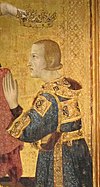

Hélène Anjou
| |
|---|---|
| Countess of Mat | |
 | |
| Born | Unknown |
| Died | 1342 Neapolitan court |
| Cause of death | Decapitation |
| Noble family | House of Anjou (by birth) House of Thopia (by marriage) |
| Spouse(s) | Andrea I Thopia |
| Issue | Karl Thopia Gjergj Thopia |
| Father | Robert, King of Naples |
| Mother | Unknown mistress |
Hélène of Anjou (Italian: Elena d'Angiò), (died in 1342 in Naples) was a member of the House of Anjou. She was an illegitimate daughter of Robert, King of Naples.

Hélène of Anjou was the daughter of Robert, King of Naples by an unknown mistress. She was one of his four illegitimate children, alongside Charles d'Artois, Louis de Bethanie and Maria d'Aquino. While her legitimate siblings were Charles, Duke of Calabria and Louis. Not much is known about Hélène's early life. When she was of age, her father had her promised to be married either to a bailiff in the Principality of Achaea, or to the Prince of Morea himself, with the latter being recorded by John Muzaka in his chronicle "Breve memoria de li discendenti de nostra casa Musachi".[1] The noblewoman was possibly due to marry Philip, son of Baldwin II[clarification needed], when her ship stopped at Durrës, where she was welcomed by Andrea I Thopia. During her stay at the coastal city, the two fell in love and married in secret, thus breaking Hélène's prior engagement arranged by her father. Their marriage resulted in two sons, Karl Thopia and Gjergj Thopia. Their son Karl was named after Hélène's famous great-grandparent Charles I of Anjou. Having found out, Robert sent a letter inviting them to Naples wanting to reconcile with his daughter and new son-in-law. After arriving he then had them secretly executed at night.[2][1][3][4] Their sons had remained in Albania, thus surviving the King's attempt. Eventually, her son Karl Thopia, rose against the Angevins managing to defeat his cousin Joanna and take control of Durrës.
Hélène married Andrea I Thopia. The pair had three children:[5]
| Ancestors of Hélène of Anjou | |||||||||||||||||||||||||||||||||||||||||||||||||||||||||||||||||||||||||||||||||||||||||||||||||||||||||||||||||||||||||||||||||||||||||||||||||||||||||||||||||||||||||||||||||||||||||||||||||||||||||||||||||||||||||||||||||||||||||||||||||||||||||||||||||||||||||||||||||||||||||||||||||||||||||||||||||||||||||||||||||||||||||||||||||||||||||||||||||||||||||||||||||||||||||||||||||||||||||||||||||||||||||||||||||||||||||||||||||||||||||||||||||||||||||||||||||||
|---|---|---|---|---|---|---|---|---|---|---|---|---|---|---|---|---|---|---|---|---|---|---|---|---|---|---|---|---|---|---|---|---|---|---|---|---|---|---|---|---|---|---|---|---|---|---|---|---|---|---|---|---|---|---|---|---|---|---|---|---|---|---|---|---|---|---|---|---|---|---|---|---|---|---|---|---|---|---|---|---|---|---|---|---|---|---|---|---|---|---|---|---|---|---|---|---|---|---|---|---|---|---|---|---|---|---|---|---|---|---|---|---|---|---|---|---|---|---|---|---|---|---|---|---|---|---|---|---|---|---|---|---|---|---|---|---|---|---|---|---|---|---|---|---|---|---|---|---|---|---|---|---|---|---|---|---|---|---|---|---|---|---|---|---|---|---|---|---|---|---|---|---|---|---|---|---|---|---|---|---|---|---|---|---|---|---|---|---|---|---|---|---|---|---|---|---|---|---|---|---|---|---|---|---|---|---|---|---|---|---|---|---|---|---|---|---|---|---|---|---|---|---|---|---|---|---|---|---|---|---|---|---|---|---|---|---|---|---|---|---|---|---|---|---|---|---|---|---|---|---|---|---|---|---|---|---|---|---|---|---|---|---|---|---|---|---|---|---|---|---|---|---|---|---|---|---|---|---|---|---|---|---|---|---|---|---|---|---|---|---|---|---|---|---|---|---|---|---|---|---|---|---|---|---|---|---|---|---|---|---|---|---|---|---|---|---|---|---|---|---|---|---|---|---|---|---|---|---|---|---|---|---|---|---|---|---|---|---|---|---|---|---|---|---|---|---|---|---|---|---|---|---|---|---|---|---|---|---|---|---|---|---|---|---|---|---|---|---|---|---|---|---|---|---|---|---|---|---|---|---|---|---|---|---|---|---|---|---|---|---|---|---|---|---|---|---|---|---|---|---|---|---|---|---|---|---|---|---|---|---|---|---|---|---|---|---|---|---|---|---|---|---|---|---|---|---|---|---|---|---|---|---|---|---|---|---|---|---|---|---|---|---|---|---|---|---|---|---|---|---|---|---|---|---|---|---|---|---|---|---|---|---|---|---|---|---|---|
| |||||||||||||||||||||||||||||||||||||||||||||||||||||||||||||||||||||||||||||||||||||||||||||||||||||||||||||||||||||||||||||||||||||||||||||||||||||||||||||||||||||||||||||||||||||||||||||||||||||||||||||||||||||||||||||||||||||||||||||||||||||||||||||||||||||||||||||||||||||||||||||||||||||||||||||||||||||||||||||||||||||||||||||||||||||||||||||||||||||||||||||||||||||||||||||||||||||||||||||||||||||||||||||||||||||||||||||||||||||||||||||||||||||||||||||||||||
… da deren Besitzungen bald darauf in der Hand jenes Tanussio Thopia (1328–1338) waren, dem König Robert von Neapel 1338 den Besitz der Grafschaft Mat bestätigte. Des letztern Sohn oder Bruder Andreas war es, der sich mit dem Hause Capet verschwägerte. König Robert, so erzählt Musachi, hatte seine natürliche Tochter dem Bailli von Morea – vielleicht dem Bertrand de Baux – zur Gattin bestimmt und sie nach Durazzo gesandt, wo damals Thopia weilte. Er verliebte sich in sie, entführte und heirathete sie. Zwei Söhne, Karl und Georg, entsprossen dieser Ehe. Aber schwer traf die Gatten bald die Rache des erzürnten Vaters; unter dem Scheine der Versöhnung lud er beide zu sich nach Neapel ein und ließ sie dort hinrichten; die Kinder aber, in denen somit wirklich das Blut der Angiovinen floß, wurden gerettet; in der festen Burg Kroja , die er später ausbaute, nicht, wie die Sage meldet , erst gründete "), wuchs Karl auf, entschlossen, den Mord des vaters zu rächen